由 by doing sth.结构谈介词by的用法
- 格式:doc
- 大小:22.00 KB
- 文档页数:3
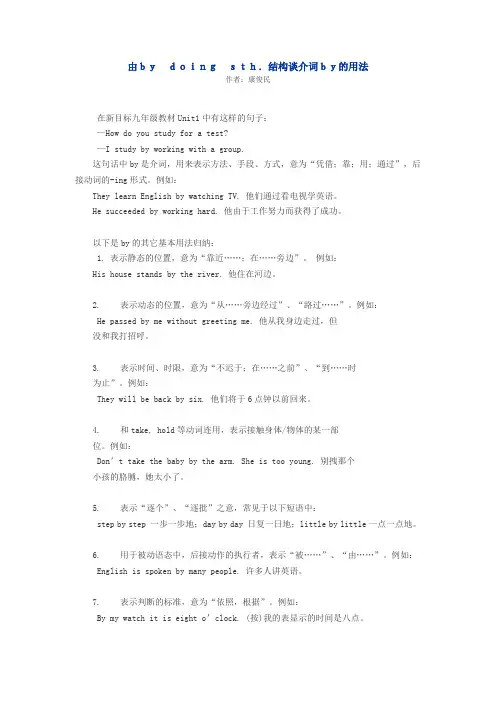
由bydoingsth.结构谈介词by的用法作者:康俊民在新目标九年级教材Unit1中有这样的句子:—How do you study for a test?—I study by working with a group.这句话中by是介词,用来表示方法、手段、方式,意为“凭借;靠;用;通过”,后接动词的-ing形式。
例如:They learn English by watching TV. 他们通过看电视学英语。
He succeeded by working hard. 他由于工作努力而获得了成功。
以下是by的其它基本用法归纳:1. 表示静态的位置,意为“靠近……;在……旁边”。
例如:His house stands by the river. 他住在河边。
2.表示动态的位置,意为“从……旁边经过”、“路过……”。
例如:He passed by me without greeting me. 他从我身边走过,但没和我打招呼。
3.表示时间、时限,意为“不迟于;在……之前”、“到……时为止”。
例如:They will be back by six. 他们将于6点钟以前回来。
4.和take, hold等动词连用,表示接触身体/物体的某一部位。
例如:Don’t take the baby by the arm. She is too young. 别拽那个小孩的胳膊,她太小了。
5.表示“逐个”、“逐批”之意,常见于以下短语中:step by step 一步一步地;day by day 日复一日地;little by little一点一点地。
6.用于被动语态中,后接动作的执行者,表示“被……”、“由……”。
例如:English is spoken by many people. 许多人讲英语。
7.表示判断的标准,意为“依照,根据”。
例如:By my watch it is eight o’clock. (按)我的表显示的时间是八点。
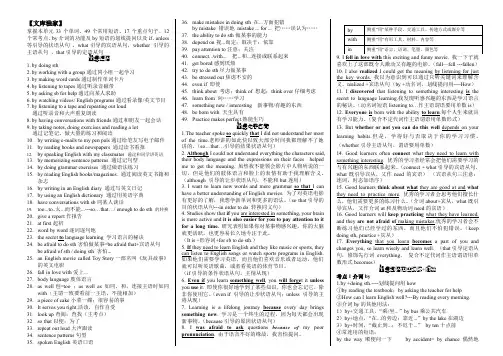
【文库独家】掌握本单元33个单词、49个常用短语、17个重点句子、12个常考点。
by介词的功能及by短语的划线提问以及if、unless 等引导的状语从句,what引导的宾语从句,whether 引导的主语从句,that引导的定语从句重点短语1.by doing sth2.by working with a group通过同小组一起学习3.by making word cards通过制作单词卡片4.by listening to tapes通过听录音磁带5.by asking sb for help通过向某人求助6.by watching videos/ English programs通过看录像/英文节目7.by listening to a tape and repeating out loud通过听录音和大声重复朗读8.by having conversations with friends通过和朋友一起会话9.by taking notes, doing exercises and reading a lot通过记笔记、做大量的练习和阅读10.by writing e-mails to my pen pals通过给笔友写电子邮件11.by reading books and newspapers 通过读书看报12.by speaking English with my classmates 通过和同学讲英语13.by memorizing sentence patterns 通过记句型14.by doing grammar exercises 通过做语法练习15.by reading English books/magazines. 通过阅读英文书籍和杂志16.by writing in an English diary 通过写英文日记17.by using an English dictionary 通过用英语字典18.have conversations with sb同某人谈话19.too...to..太...而不能...---so…that…/ enough to do sth 的转换20.give a report作报告21.at first起初22.word by word逐词逐句地23.the secret to language learning 学习语言的秘诀24.be afraid to do sth害怕做某事=be afraid that+宾语从句be afraid of sth / doing sth 害怕…25.an English movie called Toy Story一部名叫《玩具故事》的英文电影26.fall in love with爱上...27.body language肢体语言28.as well也=too ;as well as 如同、和,连接主语时如同with(主谓一致要看前一主语,不能相加)29. a piece of cake小菜一碟;很容易的事30.It serves you right.活该,自作自受31.look up查阅;查找(主考点)32.so that以便;为了33.repeat out loud大声跟读34.sentence patterns句型35.spoken English英语口语36.make mistakes in doing sth 在...方面犯错by mistake 错误地mistake … for …把……误认为……37.the ability to do sth做某事的能力38.depend on视...而定;取决于;依靠39.pay attention to注意;关注40.connect...with... 把...和...连接或联系起来41.get bored感到厌烦42.try to do sth尽力做某事43.be stressed out焦虑不安的44.even if 即使45.think about 考虑;think of 想起;think over仔细考虑46.learn from 向……学习47.something new / interesting 新事物/有趣的东西48.be born with 天生具有49.Practice makes perfect.熟能生巧重点句子必背1.The teacher spoke so quickly that I did not understand her mostof the time.老师讲的如此快以致大部分时间我都理解不了她讲的。
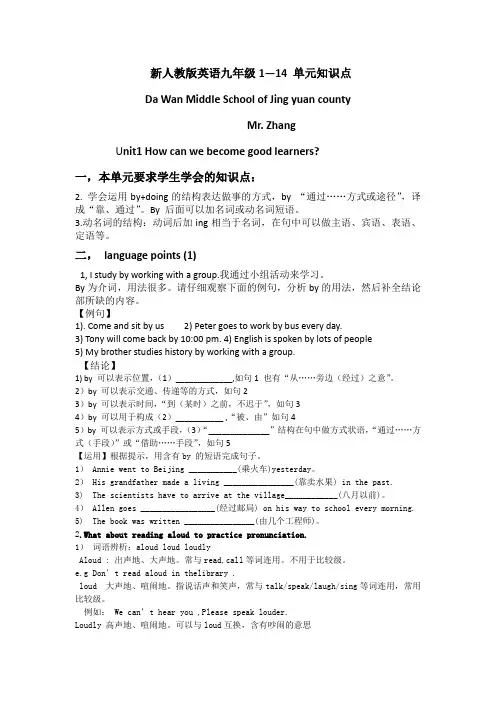
新人教版英语九年级1—14 单元知识点Da Wan Middle School of Jing yuan countyMr. ZhangU nit1 How can we become good learners?一,本单元要求学生学会的知识点:2. 学会运用by+doing的结构表达做事的方式,by “通过……方式或途径”,译成“靠、通过”。
By 后面可以加名词或动名词短语。
3.动名词的结构:动词后加ing相当于名词,在句中可以做主语、宾语、表语、定语等。
二,language points (1)1, I study by working with a group.我通过小组活动来学习。
By为介词,用法很多。
请仔细观察下面的例句,分析by的用法,然后补全结论部所缺的内容。
【例句】1). Come and sit by us 2) Peter goes to work by bus every day.3) Tony will come back by 10:00 pm. 4) English is spoken by lots of people5) My brother studies history by working with a group.【结论】1) by 可以表示位置,(1)_____________,如句1 也有“从……旁边(经过)之意”。
2)by 可以表示交通、传递等的方式,如句23)by 可以表示时间,“到(某时)之前,不迟于”,如句34)by 可以用于构成(2)___________ ,“被、由”如句45)by 可以表示方式或手段,(3)“______________”结构在句中做方式状语,“通过……方式(手段)”或“借助……手段”,如句5【运用】根据提示,用含有by 的短语完成句子。
1) Annie went to Beijing ___________(乘火车)yesterday。
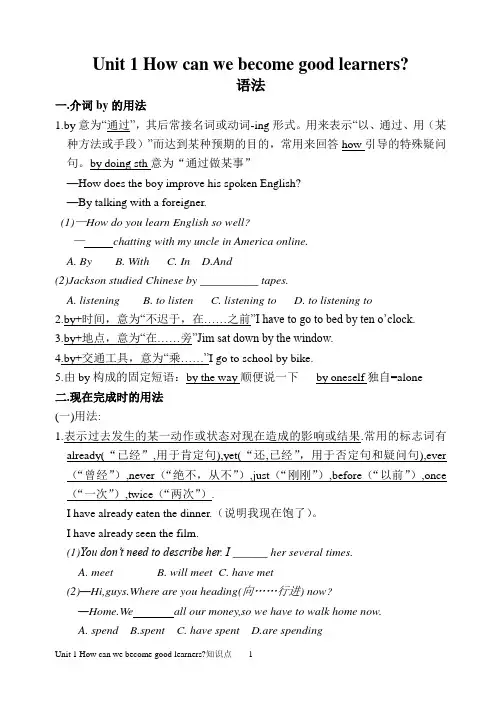
Unit 1 How can we become good learners?语法一.介词by的用法1.by意为“通过”,其后常接名词或动词-ing形式。
用来表示“以、通过、用(某种方法或手段)”而达到某种预期的目的,常用来回答how引导的特殊疑问句。
by doing sth意为“通过做某事”—How does the boy improve his spoken English?—By talking with a foreigner.(1)—How do you learn English so well?—chatting with my uncle in America online.A. ByB. WithC. InD.And(2)Jackson studied Chinese by __________ tapes.A. listeningB. to listenC. listening toD. to listening to2.by+时间,意为“不迟于,在……之前”I have to go to bed by ten o’clock.3.by+地点,意为“在……旁”Jim sat down by the window.4.by+交通工具,意为“乘……”I go to school by bike.5.由by构成的固定短语:by the way顺便说一下by oneself独自=alone二.现在完成时的用法(一)用法:1.表示过去发生的某一动作或状态对现在造成的影响或结果.常用的标志词有already(“已经”,用于肯定句),yet(“还,已经”,用于否定句和疑问句),ever (“曾经”),never(“绝不,从不”),just(“刚刚”),before(“以前”),once (“一次”),twice(“两次”).I have already eaten the dinner.(说明我现在饱了)。
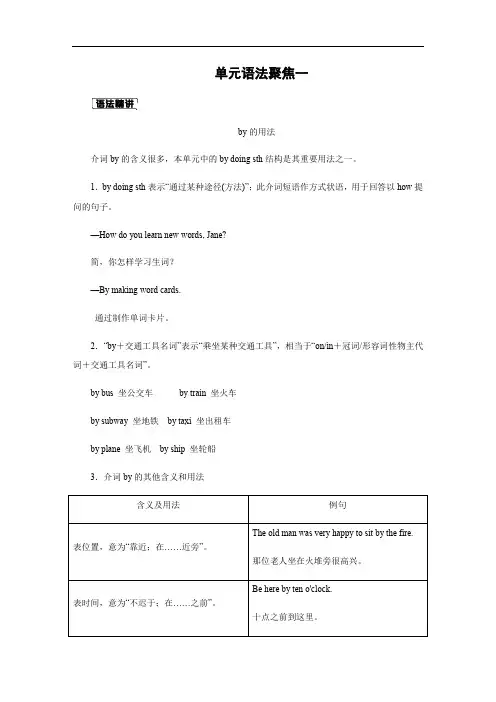
单元语法聚焦一by的用法介词by的含义很多,本单元中的by doing sth结构是其重要用法之一。
1.by doing sth表示“通过某种途径(方法)”;此介词短语作方式状语,用于回答以how提问的句子。
—How do you learn new words, Jane?简,你怎样学习生词?—By making word cards.通过制作单词卡片。
2.“by+交通工具名词”表示“乘坐某种交通工具”,相当于“on/in+冠词/形容词性物主代词+交通工具名词”。
by bus 坐公交车by train 坐火车by subway 坐地铁by taxi 坐出租车by plane 坐飞机by ship 坐轮船3.介词by的其他含义和用法4.介词by的固定搭配day by day 一天天bit by bit 一点一点地by accident 偶然by mistake 错误地;无意中one by one 逐个地;逐一地by the end of… 到……末为止by the time 到……的时候Ⅰ.单项选择()1.2018·河池改编You can improve your English ________ listening to English songs.A.by B.for C.in()2.2018·青岛改编More and more people in Qingdao go to work ________ subway now.A.on B.in C.by()3.The teacher was standing________ the window while the students were doing their homework quietly.A.for B.on C.by()4.The classroom was cleaned ________ Lucy just now.A.for B.by C.to()5.You have to get home ________ 10 o'clock.A.with B.on C.byⅡ.根据汉语意思完成句子1.我父亲经常坐公交车去上班,我总是步行去上学。

介词用法知多少介词是英语中最活跃的词类之一。
同一个汉语词汇在英语中可译成不同的英语介词。
例如汉语中的“用”可译成:(1)用英语(in English);(2)用小刀(with a knife);(3)用手工(by hand);(4)用墨水(in ink)等。
所以,千万不要以为记住介词的一两种意思就掌握了这个介词的用法,其实介词的用法非常广泛,搭配能力很强,越是常用的介词,其含义越多。
下面就简单介绍几组近义介词的用法及其搭配方法。
一. in, to, on和off在方位名词前的区别1. in表示A地在B地范围之内。
如:is in the southeast of .2. to表示A地在B地范围之外,即二者之间有距离间隔。
如:lies to the east of .3. on表示A地与B地接壤、毗邻。
如:is on the east of .4. off表示“离……一些距离或离……不远的海上”。
如:They arrived at a house off the main road.lies off the eastern coast of .二. at, in, on, by和through在表示时间上的区别1. at指时间表示:(1)时间的一点、时刻等。
如:They came home at sunrise (at noon, at midnight, at ten o’clock, at daybreak, at dawn).(2)较短暂的一段时间。
可指某个节日或被认为是一年中标志大事的日子。
如:He went home at Christmas (at New Year, at the Spring Festival, at night).2. in指时间表示:(1)在某个较长的时间(如世纪、朝代、年、月、季节以及泛指的上午、下午或傍晚等)内。
如:in 2004, in March, in spring, in the morning, in the evening, etc(2)在一段时间之后。
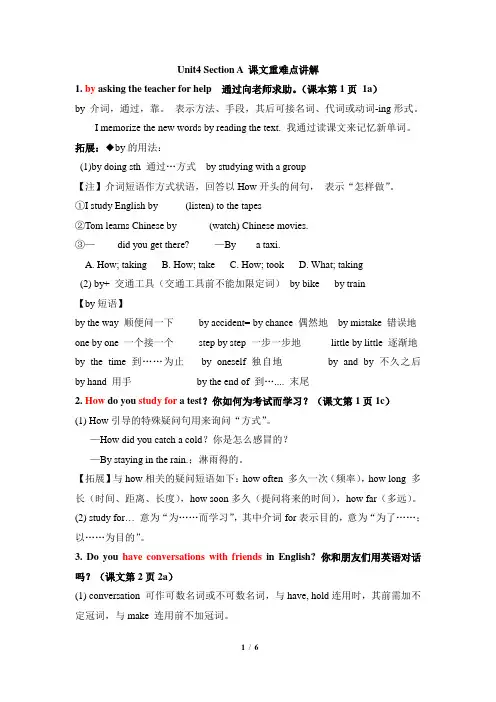
Unit4 Section A 课文重难点讲解1. by asking the teacher for help 通过向老师求助。
(课本第1页1a)by 介词,通过,靠。
表示方法、手段,其后可接名词、代词或动词-ing形式。
I memorize the new words by reading the text. 我通过读课文来记忆新单词。
拓展:◆by的用法:(1)by doing sth 通过…方式by studying with a group【注】介词短语作方式状语,回答以How开头的问句,表示“怎样做”。
①I study English by _____(listen) to the tapes②Tom learns Chinese by ______(watch) Chinese movies.③—____ did you get there? —By ___ a taxi.A. How; takingB. How; takeC. How; tookD. What; taking(2) by+ 交通工具(交通工具前不能加限定词)by bike by train【by短语】by the way 顺便问一下by accident= by chance 偶然地by mistake 错误地one by one 一个接一个step by step 一步一步地little by little 逐渐地by the time 到……为止by oneself 独自地by and by 不久之后by hand 用手by the end of 到….... 末尾2. How do you study for a test?你如何为考试而学习?(课文第1页1c)(1) How引导的特殊疑问句用来询问“方式”。
—How did you catch a cold?你是怎么感冒的?—By staying in the rain.;淋雨得的。
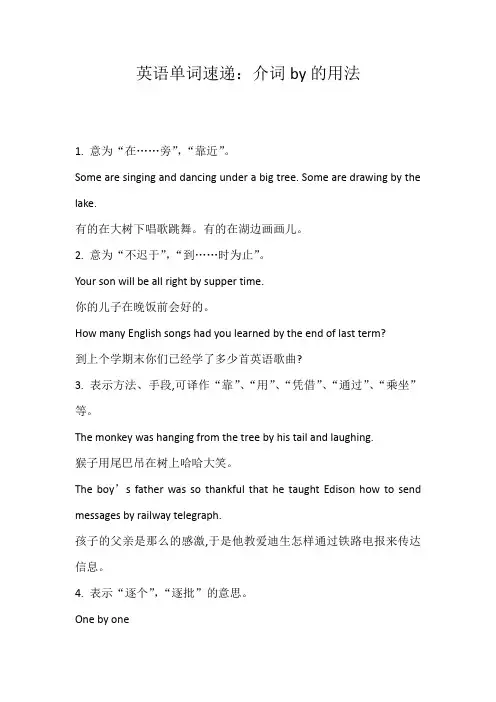
英语单词速递:介词by的用法
1. 意为“在……旁”,“靠近”。
Some are singing and dancing under a big tree. Some are drawing by the lake.
有的在大树下唱歌跳舞。
有的在湖边画画儿。
2. 意为“不迟于”,“到……时为止”。
Your son will be all right by supper time.
你的儿子在晚饭前会好的。
How many English songs had you learned by the end of last term?
到上个学期末你们已经学了多少首英语歌曲?
3. 表示方法、手段,可译作“靠”、“用”、“凭借”、“通过”、“乘坐”等。
The monkey was hanging from the tree by his tail and laughing.
猴子用尾巴吊在树上哈哈大笑。
The boy’s father was so thankful that he taught Edison how to send messages by railway telegraph.
孩子的父亲是那么的感激,于是他教爱迪生怎样通过铁路电报来传达信息。
4. 表示“逐个”,“逐批”的意思。
One by one。
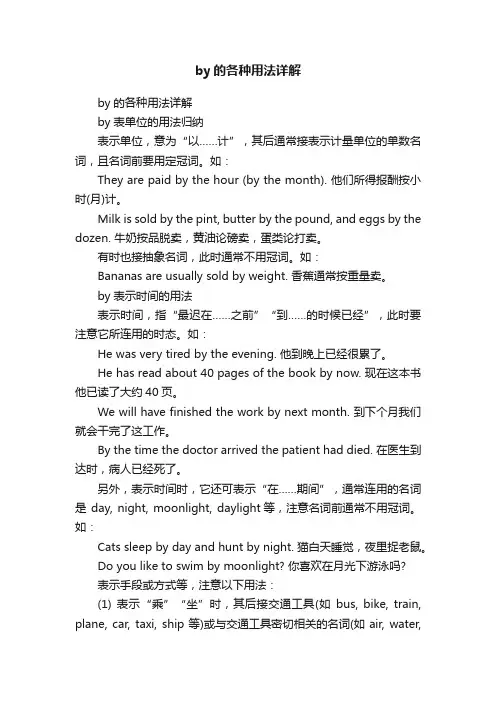
by的各种用法详解by的各种用法详解by表单位的用法归纳表示单位,意为“以……计”,其后通常接表示计量单位的单数名词,且名词前要用定冠词。
如:They are paid by the hour (by the month). 他们所得报酬按小时(月)计。
Milk is sold by the pint, butter by the pound, and eggs by the dozen. 牛奶按品脱卖,黄油论磅卖,蛋类论打卖。
有时也接抽象名词,此时通常不用冠词。
如:Bananas are usually sold by weight. 香蕉通常按重量卖。
by表示时间的用法表示时间,指“最迟在……之前”“到……的时候已经”,此时要注意它所连用的时态。
如:He was very tired by the evening. 他到晚上已经很累了。
He has read about 40 pages of the book by now. 现在这本书他已读了大约40页。
We will have finished the work by next month. 到下个月我们就会干完了这工作。
By the time the doctor arrived the patient had died. 在医生到达时,病人已经死了。
另外,表示时间时,它还可表示“在……期间”,通常连用的名词是day, night, moonlight, daylight等,注意名词前通常不用冠词。
如:Cats sleep by day and hunt by night. 猫白天睡觉,夜里捉老鼠。
Do you like to swim by moonlight? 你喜欢在月光下游泳吗?表示手段或方式等,注意以下用法:(1) 表示“乘”“坐”时,其后接交通工具(如bus, bike, train, plane, car, taxi, ship等)或与交通工具密切相关的名词(如air, water,land, road等),在句中主要用作方式状语,其中通常不用冠词或其他限定词。
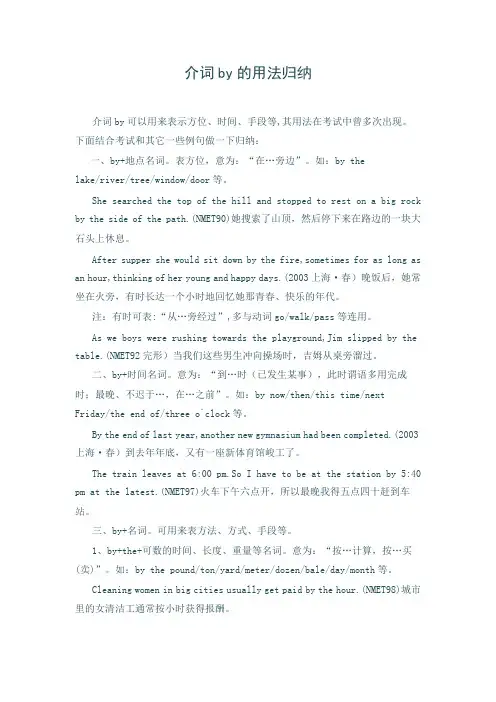
介词by的用法归纳介词by可以用来表示方位、时间、手段等,其用法在考试中曾多次出现。
下面结合考试和其它一些例句做一下归纳:一、by+地点名词。
表方位,意为:“在…旁边”。
如:by thelake/river/tree/window/door等。
She searched the top of the hill and stopped to rest on a big rock by the side of the path.(NMET90)她搜索了山顶,然后停下来在路边的一块大石头上休息。
After supper she would sit down by the fire,sometimes for as long as an hour,thinking of her young and happy days.(2003上海·春)晚饭后,她常坐在火旁,有时长达一个小时地回忆她那青春、快乐的年代。
注:有时可表:“从…旁经过”,多与动词go/walk/pass等连用。
As we boys were rushing towards the playground,Jim slipped by the table.(NMET92完形)当我们这些男生冲向操场时,吉姆从桌旁溜过。
二、by+时间名词。
意为:“到…时(已发生某事),此时谓语多用完成时;最晚、不迟于…,在…之前”。
如:by now/then/this time/nextFriday/the end of/three o`clock等。
By the end of last year,another new gymnasium had been completed.(2003上海·春)到去年年底,又有一座新体育馆峻工了。
The train leaves at 6:00 pm.So I have to be at the station by 5:40 pm at the latest.(NMET97)火车下午六点开,所以最晚我得五点四十赶到车站。

九年级Unit 1Grammar1.介词引导的方式状语(扩充by 的用法)1. by +n. 通过by+ doing 在句中作方式状语,常用来表示“以,靠,借助,通过,用”某种方法或手段达到某种预期的目的。
Eg. I made a coat with my own hands. It was made by hand, not by machine.我亲手做了一件外套。
它不是由机器做的,而是手工做成的。
You can realize your dream by working hard.通过努力,你可以实现你的梦想。
2. with+ n. (有形)表示用某种工具或身体的某个部位。
Eg. He often writes with his left hand.他常常用左手写字。
3. through +n. 指方法或手段时,“经由,通过,以”/+空间n.Eg. We can see many stars in the sky through telescopes.通过望远镜我们可以看到天空中的许多星星。
4. in+ n. 表示用某种材料或语言Eg. Please answer this question in English.请用英语回答这个问题。
5. on+n. (交通工具或电信工具)在电话中常用on/over the phoneEg. I have learned many English songs on TV.我通过电视学了很多英文歌。
by 作介词的用法(扩充)(1)by+ doing “用……手段方式”(2)by+交通工具, “乘坐……交通工具”(3) by+地点n. 表方位, “在……旁边”(4)by+时间n. “到时候”(5)by 用于构成被动语态,表示“被,由”。
have free talk with sb. 与某人闲谈take notes 记笔记It's no use doing sth.做某事徒劳无益It's known to all that+从句,表示“众所周知……”It+be+过去分词+主语从句,it作形式主语代替that从句2.It 的用法(作形式主语, 形式宾语,代词)1.作形式主语动词不定式、动名词或主语从句作主语时,通常把它们放在谓语之后,而将it 置于句首,作形式主语1. It is/was +adj.+(for sb.) to do sth.表示做某事对某人来说怎么样,侧重于事件对人的影响常用easy, difficult, hard, important, possible, wise等形容词作表语。
介词by的用法★山西李军雯本单元by + v.-ing结构是一个重点,该结构意思是“通过……,以……的方式”,后面常接v.-ing形式,表示“通过某种方式得到某种结果”。
e.g. I practice speaking English by joining an English-language club.我通过加入一个英语语言俱乐部来练习讲英语。
Mr Li makes a living by driving taxis.李先生靠开出租车为生。
介词by + v.-ing 结构常用来回答How do you...?或How can I...?之类的问题。
e.g. —How do you learn English? 你怎样学习英语呢?—I learn English by reading aloud. 我通过大声朗读来学英语。
—How can I turn on the computer? 我怎样才能打开电脑呢?—By pressing this button. 按这个按钮。
[相关链接]by 是个常用介词,其他用法还有:①表示位置,意思是“在……旁边”,“靠近……”,有时可与beside 互换。
e.g. The girls are playing by (beside) the lake.女孩们正在湖边玩。
②表示交通方式,意为“乘坐”。
e.g. Jim often goes to work by bike. 吉姆常骑自行车上班。
③表示时间,意思是“在……以前;不迟于”。
e.g. My mother will come back by 6:00. 我妈妈将在六点前回来。
趁热打铁用by短语完成下列句子。
1. Li Ming went to London ___________ (乘飞机).2. Mrs Smith makes a living __________ (靠卖水果).3. She sat ___________ (在窗边) looking out over the fields.4. Let's review the new words _____________(通过制作) vocabulary lists.5. The work should be finished ____________ (下星期五前).。
由bydoingsth.结构谈介词by的用法在新目标九年级教材Unit1中有这样的句子:—How do you study for a test?—I study by working with a group.这句话中by是介词,用来表示方法、手段、方式,意为“凭借;靠;用;通过”,后接动词的-ing形式。
例如:They learn English by watching TV. 他们通过看电视学英语。
He succeeded by working hard. 他由于工作努力而获得了成功。
以下是by的其它基本用法归纳:1. 表示静态的位置,意为“靠近……;在……旁边”。
例如:His house stands by the river. 他住在河边。
2. 表示动态的位置,意为“从……旁边经过”、“路过……”。
例如:He passed by me without greeting me. 他从我身边走过,但没和我打招呼。
3. 表示时间、时限,意为“不迟于;在……之前”、“到……时为止”。
例如:They will be back by six. 他们将于6点钟以前回来。
4. 和take, hold等动词连用,表示接触身体/物体的某一部位。
例如:Don’t take the baby by the arm. She is too young. 别拽那个小孩的胳膊,她太小了。
5. 表示“逐个”、“逐批”之意,常见于以下短语中:step by step 一步一步地;day by day 日复一日地;little by little一点一点地。
6. 用于被动语态中,后接动作的执行者,表示“被……”、“由……”。
例如:English is spoken by many people. 许多人讲英语。
7. 表示判断的标准,意为“依照,根据”。
例如:By my watch it is eight o’clock. (按)我的表显示的时间是八点。
by的用法小结:1、介词prep. 在…旁;靠近· Our teacher was sitting by the window.我们的老师正坐在窗户旁边。
· Stand by me!站到我的身旁来!· We spent our holiday by the sea.我们在海边度假。
2、介词prep. 经过· He walked by me without speaking.他走过我的身旁,没有说话。
· My brother goes by the building every day.我弟弟每天从这楼旁走过。
3、介词prep. 用;靠;通过using (showing who or what did something)· I know it by heart.我把它记在心头。
· They can read by touch.他们可以通过手摸来阅读。
· By getting up early, I can have an hour for reading English in the morning. 靠起得早,我每天早晨有一小时时间阅读英语。
4、介词prep. 不迟于not later than· I shall be back by 5 o'clock.最迟五点我一定回来。
· How many English parties had you had by the end of last term?到上学期末,你们举行了几次英语晚会?5、介词prep. 通过;沿着through; along; over· We came through the fields, not by the road.我们是穿过田野而不是沿那条路来的。
· to send a letter by post通过邮局寄信6、介词prep. (表示作者)被;由word that shows the author, painter, etc.· Thirty divided by two is fifteen.三十除以二得十五。
介词by的用法1.表示“在...旁边”sit by the window 坐在窗户旁边stand by me 站在我旁边walk by the river 在河边走2.表示“从...旁经过”,常跟go/walk/pass连用Go by/walk by/pass by 走路经过3.表示使用交通工具by bus/plane/bike/train/shipby air/land/water 乘飞机/ 由陆路/ 由水路4.表示被动语态:被,由be saved by sb 被某人救了be caught by .. 被...抓住了be built by... 被...建造的5.表示方法,手段:用,通过by doing sth 通过做某事learn English by listening to tapes 通过听磁带来学英语by heart 用心by check/credit card 用支票、信用卡6.表示时间:不迟于,在...之前by + 具体时刻by + 年份by the time of + 表示时间的短语(如last year,next month,next year等)by the time + 句子I will be back by 6 o’clock.By 2010, I had learnt 2000 English words.By the time of last year,I had lived in WZ for 5 years.By the time I was 5,I had learnt to ride a bike.7.表示增减的程度increase by 10% 增加10%decrease by 20% 减少20%8.by+表示时间、长度、重量的总称名词,表示“按...计算”“按...买卖”by time 按时间by size 按大小by weight 按重量by volume 按体积by length 按长度by height 按高度by area 按面积by depth 按深度9.by+the+具体的,可数的时间、长度、重量的名词,表示“按....计算”“按...买卖”by the hour 按小时by the day 按天by the month 按月by the dozen 按打by the year 按年by the ton 按吨10.by+身体部位或衣服,表示抓住身体或衣服的某一部分,常与动词catch/hold/grab/seize/take等连用Catch sb by the hand/arm/hair 抓住某人的手/胳膊/头发Grab sb by the collar/sleeve 抓住某人的衣领/袖子11.用于“名词+by+名词”结构one by one 一个接一个step by step 一步步地day by day 一天一天地week by week 一个星期接一个星期的shoulder by shoulder 肩并肩的12.其他带有by的短语或句型What do you mean by....? 你说...是什么意思?What’s the time by your watch? 你的表几点了?by the way 顺便一说,顺便一问by oneself 独自一人by chance/by accident 偶然地无意的by design 故意的by nature 天生的By way of 经由,途径The batch of goods will be delivered by way of Hong Kong.这批货物将经由香港发货。
by小结1.用于被动语态的句子中,表示动作的执行者,意为“被;由”。
He was praised by the teacher.他受到了老师的表扬。
The book was written by Lu Xun.这本书是鲁迅写的。
2.表示方式、方法、手段等,后常接无冠词的名词或动名词,意为“通过;靠;用”。
Don't judge a person by appearances. 勿以貌取人。
He made a living by teaching.他以教书为生。
3.表示时间,意为“到……时(为止”或“不迟于……”)。
He ought to be here by now.他现在应该在这儿了。
By the time he was ten, he had learnt about 1,000 English words.到十岁时,他已学了约一千个英语单词。
4.表示(增减)程度,尺寸数量等,意为“至……的程度”。
the bullet missed me by two inches.那子弹以两英寸之差未击中我。
the rope needs to be longer by two feet.这绳子需要再长两英尺。
5.表示交通路线或工具,后接名词不用冠词,意为“乘;坐”。
go by bus / plane / train 乘汽车(飞机、火车)去travel by land / sea / air 陆上(海上、空中)旅行6.表示位置,意为“在近旁;在……旁边”。
There is a pumping station by the river.河边有个抽水站。
下面结合高考试卷和其它一些例句做一下归纳:一、by+地点名词。
表方位,意为:“在…旁边”。
如:by the lake/river/tree/window/door等。
She searched the top of the hill and stopped to rest on a big rock by the side of the path.她搜索了山顶,然后停下来在路边的一块大石头上休息。
由bydoingsth.结构谈介词by的用法
—How do you study for a test?
—I study by working with a group.
这句话中by是介词,用来表示方法、手段、方式,意为“凭借;靠;用;通过”,后接动词的-ing形式。
例如:
They learn English by watching TV. 他们通过看电视学英语。
He succeeded by working hard. 他由于工作努力而获得了成功。
以下是by的其它基本用法归纳:
1. 表示静态的位置,意为“靠近……;在……旁边”。
例如:
His house stands by the river. 他住在河边。
2. 表示动态的位置,意为“从……旁边经过”、“路过……”。
例如:
He passed by me without greeting me. 他从我身边走过,但没和我打招呼。
3. 表示时间、时限,意为“不迟于;在……之前”、“到……时
为止”。
例如:
They will be back by six. 他们将于6点钟以前回来。
4. 和take, hold等动词连用,表示接触身体/物体的某一部
位。
例如:
Don’t take the baby by the arm. She is too young. 别拽
那个
小孩的胳膊,她太小了。
5. 表示“逐个”、“逐批”之意,常见于以下短语中:
step by step 一步一步地;day by day 日复一日地;little by little一点一点地。
6. 用于被动语态中,后接动作的执行者,表示“被……”、“由……”。
例如:
English is spoken by many people. 许多人讲英语。
7. 表示判断的标准,意为“依照,根据”。
例如:
By my watch it is eight o’clock. (按)我的表显示的时间是八点。
8. 表示交通、传递的方式。
例如:
I often go to school by bus. 我经常坐公共汽车上学。
9. 表示原因,意为“由于……的结果,凭着”。
例如:
By good fortune, I succeeded the first time. 我侥幸地第一次就成功了。
10. 由by还可以构成以下短语:
(1) (all) by oneself 意为“独自地”、“单独地”。
(2) by the way “顺便说一声”、“顺便问一下”,常用作插入语。
(3) by chance / by accident 意为“偶然地”。
(4) learn by heart 意为“背会、记住”。
(5) by mistake意为“误会、弄错”。
(6) by far用于修饰比较级、最高级,以加强语气。
例如:
He is by far the tallest in our class. 在我们班他个子最高。